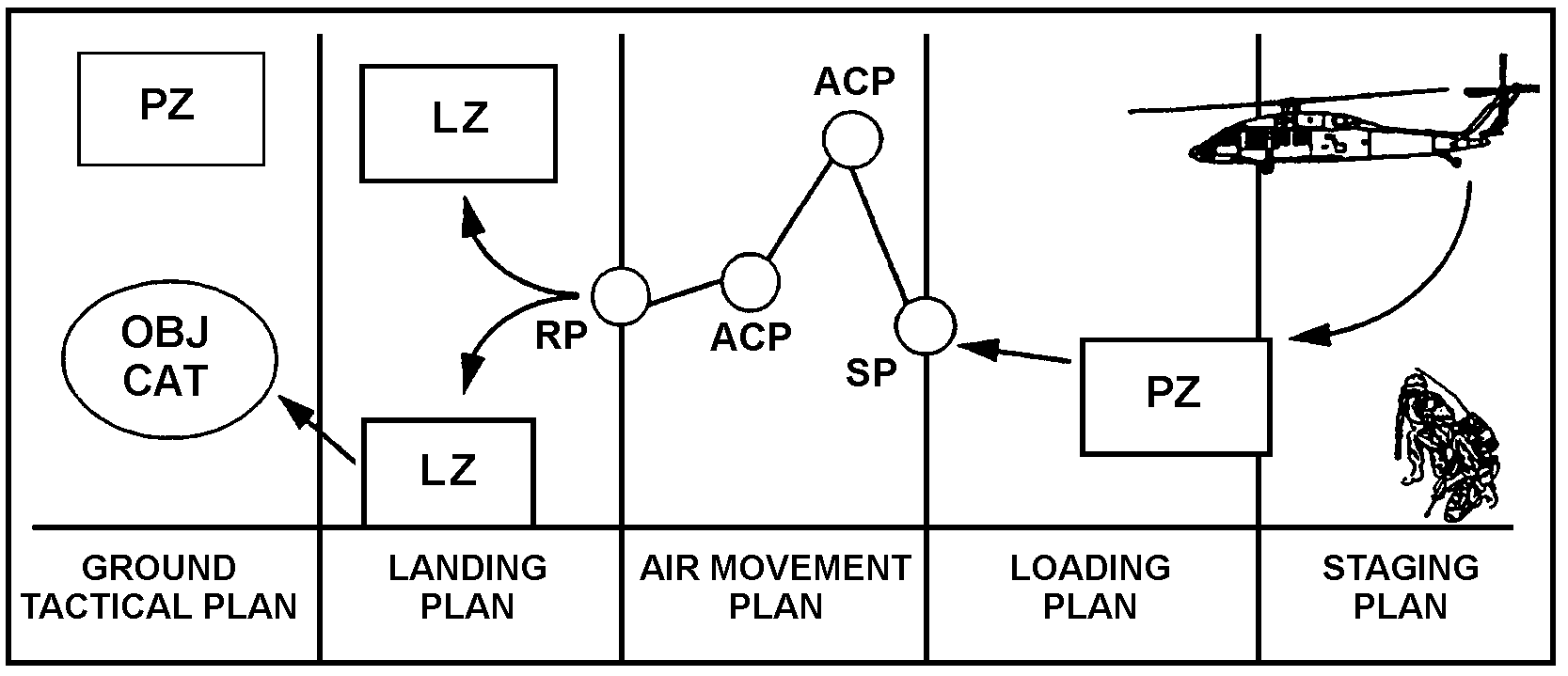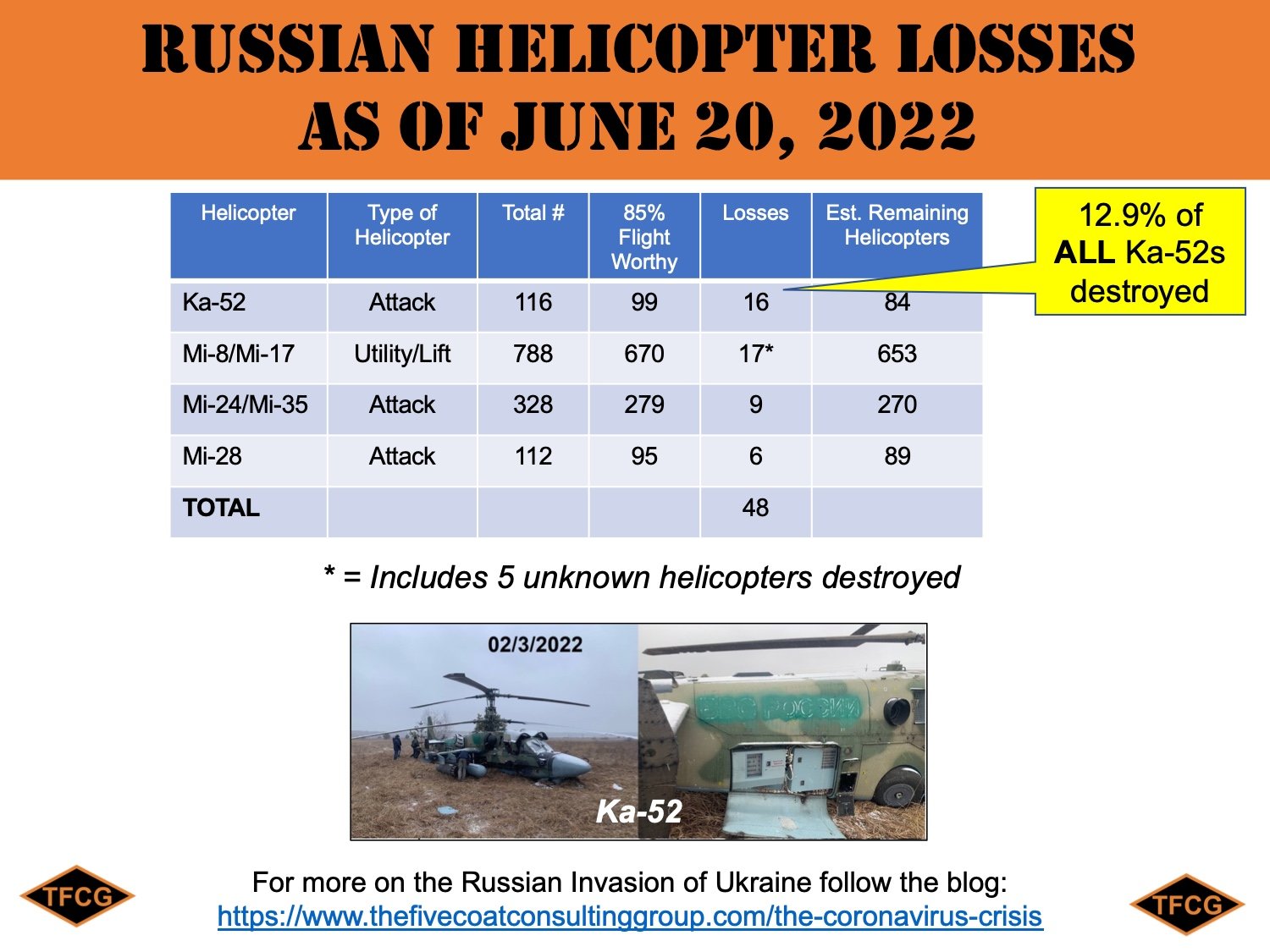Invasion of Ukraine, D+117 SITREP + Air Assault Operations (#219)
Today, June 21, 2022, is D+117 in the Russian Invasion of Ukraine. This blog post discusses air assault operations and Russian helicopter losses during the past four months. It also continues the crowd sourced Battle Damage Assessment update since the beginning of the Russian Invasion of Ukraine.
Air Assault Operations
At the beginning of the war, Russian forces attempted air assault operations as they tried to seize Kyiv. An air assault operation is the movement of ground-based military forces by helicopters to seize and hold key terrain which has not been fully secured or to directly engage enemy forces behind enemy lines. We haven’t seen any air assault operations lately, but as the war drags on, Russia may try an air assault to seize an opportunity that presents itself.
An air assault operation is an operation that uses helicopters to insert a Russian Battalion Tactical Group’s (BTG — the core organization of Russia’s Army — see more at BTGs, OoB, and Crowd Sourced BDA in Ukraine, D+11) infantry soldiers into enemy territory during day or night. Their mission is to seize an objective within range of artillery (i.e., within about 15 kilometers of the line of contact) and eventually link up with an advancing friendly force within hours. Typical missions for an air assault are neutralization of enemy command, control, and communications facilities; seizure of critical terrain such as an opposite shore of a river crossing site; attack enemy defense positions from the rear; neutralization or disruption of enemy logistics elements; or as part of a deception operation. I talked at length last week about river crossing operations.
All air assault operations are planned in five phases. Units plan air assaults using a backwards planning method (i.e. Phase V to Phase I). I talked more about how you can use the backwards planning method here. The five basic phases of an air assault operation are Phase V — Ground Tactical Plan; Phase IV — Landing; Phase III — Air Movement; Phase II — Loading; and Phase I — Staging.
Phase V — Ground Tactics — The unit’s task and purpose after it arrives on the Landing Zone or LZ. For example, it might be to “seize the exit bank objective in order to prevent observed fires on the BTG’s river crossing site.” UAVs, attack helicopters, fixed wing aviation, artillery, mortars, and jamming will shift their focus to supporting the accomplishment of the unit’s task and purpose or shaping future operations. Often during this phase planners designate an alternate pick-up zone to use to either extract the ground forces or to evacuate wounded from.
Phase IV — Landing — Troops and equipment arrive at the LZ according to a precise sequence. Combat power (Remember, combat power is “the total means of destructive, constructive, and information capabilities that a military unit or formation can apply at a given time.”) is grown to support the ground tactical plan. UAVs, attack helicopters, fixed wing aviation, artillery, mortars, and jamming continue to Suppress Enemy Air Defenses (or SEAD), especially to cover the exfiltration routes of the helicopters.
Phase III — Air Movement — Troops, equipment, and supplies are moved from the Pick-up Zone or PZ to the LZ along specific air routes and at specific times. Often it takes multiple lifts of aircraft (i.e. 3 Mi-8s may have to do two trips to carry an entire Russian infantry company to the LZ). Planners designate the Start Point or SP, Aerial Check Points or ACPs, and the Release Point or RP along the air route. UAVs, attack helicopters, fixed wing aviation, artillery, mortars, and jamming continue to Suppress Enemy Air Defenses (or SEAD) along the route(s) and in vicinity of the LZ.
Phase II — Loading — During Phase II, troops, equipment, and supplies are loaded on the correct aircraft. Detailed load planning ensures the unit arrives at the Landing Zone or LZ configured to accomplish the ground tactical plan. For a dismounted infantry company it is important to have mortars, machine guns, and anti-tank weapons arrive in the first lift. Other, lower priority assets, can arrive in the second lift. UAVs, attack helicopters, fixed wing aviation, artillery, mortars, and jamming continue to Suppress Enemy Air Defenses (or SEAD).
Phase I — Staging — In this phase, people and equipment move to the Pickup Zone or PZ. Also, helicopters move in the proper order to the PZ. UAVs, attack helicopters, fixed wing aviation, artillery, mortars, and jamming are used to Suppress Enemy Air Defenses (or SEAD) along the air routes and in the vicinity of the LZ.
Helicopter Losses
Neither side over the past four months has been able to maintain air superiority over the battlefield. Anti-aircraft guns and missiles has made it challenging to operate both rotary wing and fixed wing aircraft.
Since February, Russia has used 4 types of helicopters in the Invasion of Ukraine:
Ka-52 — Known as the “Alligator” or “Hokum B” it is a single or double seat attack helicopter which is used in a scouting role. It features a unique coaxial rotor system (which requires no tail rotor), a 30mm auto cannon, and an ejection seat for the pilot. It can also carry laser guided anti-tank missiles and “dumb” rockets.
Mi-8/Mi-17 — Known as the “Hip” it is the most widely operated helicopter in the world with over 12,000 produced. It is a medium utility helicopter that has a crew of 3 and can carry 24 troops, 12 stretchers, or 4,000 kg/8,818 lbs cargo internally.
Mi-24/Mi-35 — the Russian Army’s main gunship which is known as the “Hind.” It is a large helicopter gunship and low-capacity troop transport with room for 8 passengers. Most are armed with a 12.7 mm Yakushev-Borzov Yak-B Gatling gun. It can carry guided anti-tank missiles, “dumb” rockets, and bombs on its external pods.
Mi-28 — the Russian Army’s all-weather, day-night, tandem, two-seat, attack helicopter. It is known as the “Havoc” It is armed with a 30 mm automatic Shipunov 2A42 auto cannon, guided anti-tank missiles, air-to-air missiles, “dumb” rockets, and bombs on its external pods.
Potential future air assault operations would combine Mi-8/Mi-17 helicopters to carry the infantry soldiers, and one or all of the three attack helicopters (Ka-52s, Mi-24/Mi-35, and/or Mi-28). Compared to the amount of tanks, BMPs, and BTRs the Russian Army has lost in the war, its helicopter losses have been relatively light.
Bottom Line: The Russian Army has retained much of its rotary wing capabilities and remains able to conduct air assault operations this summer.
Total Russian BDA (As of June 20, 2022 at 15:00 EDT) the Oryx Website
Russian forces have lost since the war began:
786x T-64/72/80/90s Tanks damaged, destroyed, abandoned and captured
Average of 6.7x tanks damaged, destroyed, abandoned and captured per day
1,155x BMPs/BTRs/BMDs (Armored Personnel Carriers) damaged, destroyed, abandoned and captured
Average of 9.9x BMPs/BTRs damaged, destroyed, abandoned and captured per day
166x Engineer Vehicles (Including the 89 different bridging capabilities described above) damaged, destroyed, abandoned and captured
269x 152 mm 2S19 Msta and BM-21 122mm MLRS (Field Artillery) damaged, destroyed, abandoned and captured
86x Air Defense Artillery Weapons or Surface to Air Missile Vehicles damaged, destroyed, abandoned and captured
224x MT-LB ACRV (Command and Control) damaged, destroyed, abandoned and captured
For More Information on the Conflict:
Invasion of Ukraine, D+110 SITREP + River Crossing
Invasion of Ukraine, D+103 SITREP
Invasion of Ukraine, D+89 SITREP
BTGs, OoB, and Crowd Sourced BDA in Ukraine, D+11
Conclusion
Want even more? Reach out to me me here for a virtual talk to your group or company on the Invasion of Ukraine and its tactical and strategic implications.
Want something different? In my day job, I’m an executive coach and leadership consultant. I published a book last summer on how to develop your perseverance and accomplish your goals — Grow Your Grit, available for sale at Amazon. Or reach out to me here to start the discussion about executive coaching opportunities.
Use your deeper awareness of the invasion of Ukraine to go on the offensive and follow the conflict with better insight.



